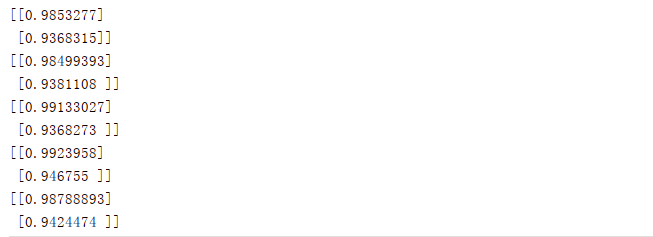常用的损失函数有:
1.均方误差: tf.reduce_mean(tf.square(真实值 - 预测值))
2.自定义损失函数:
3.交叉熵:tf.nn.softmax_cross_entropy_with_logits(lables = 真实值, logits = 预测值)
通过预测酸奶日销量与影响因素x1,x2之间关系,理解损失函数的用法。
1.均方误差: tf.reduce_mean(tf.square(真实值 - 预测值))
import tensorflow as tf import numpy as np BATCH_SIZE = 8 STEP = 5000 * BATCH_SIZE LR = 1e-3 np.random.seed(1) #构建数据集 X = np.random.random([32, 2]) Y_ = [[x1 + x2 + (np.random.rand()/10 - 0.05)] for x1, x2 in X] #定义占位符 x = tf.placeholder(tf.float32, shape=(None, 2)) y_ = tf.placeholder(tf.float32, shape=(None, 1)) #定义权重 W1 = tf.Variable(tf.random_normal([2, 1], stddev=1)) # W2 = tf.Variable(tf.random_normal([3, 1], stddev=1)) #构建前向传播过程 y = tf.matmul(x, W1) # y = tf.matmul(a, W2) #定义损失函数,梯度下降减小损失 loss = tf.reduce_mean(tf.square(y_ - y)) train_step = tf.train.GradientDescentOptimizer(LR).minimize(loss) #创建会话,开始训练 with tf.Session() as sess: init = tf.global_variables_initializer() sess.run(init) length = len(X) for i in range(STEP): start = (i * BATCH_SIZE) % length end = start + BATCH_SIZE sess.run(train_step, feed_dict={x: X[start: end], y_: Y_[start: end]}) if i % 1000 == 0: loss_ = sess.run(loss, feed_dict={x: X, y_: Y_}) # print(i, loss_) print(sess.run(W1))
打印结果:

W1中的x1权重与x2的权重是在逐渐接近于1,与我们之间的生成公式是一致的。
上述代码是使用均方误差来减小损失,从而默认认为销量预测多了或者预测少了都是一样的,而实际上预测多了损失的是成本,预测少了损失的是利润。
所以在这里使用均方误差作为损失函数是没法讲利益最大化的,所以就要用到自定义的损失函数。
计算预测值与真实值之间的损失的累计和,所以可以吧损失定义为一个分段函数。
# loss = tf.reduce_mean(tf.square(y_ - y))
#tf.greater(y, y_) a > b ? 输出true, false
#tf.where(条件语句, 为True执行, 为False执行)
loss = tf.reduce_sum(tf.where(tf.greater(y, y_), (y - y_)*COST, (y_ - y)*PROFIT))
import tensorflow as tf import numpy as np BATCH_SIZE = 8 STEP = 5000 * BATCH_SIZE LR = 1e-3 COST = 1 PROFIT = 9 if __name__ == '__main__': np.random.seed(1) # 构建数据集 X = np.random.random([32, 2]) Y_ = [[x1 + x2 + (np.random.rand() / 10 - 0.05)] for x1, x2 in X] # 定义占位符 x = tf.placeholder(tf.float32, shape=(None, 2)) y_ = tf.placeholder(tf.float32, shape=(None, 1)) # 定义权重 W1 = tf.Variable(tf.random_normal([2, 1], stddev=1)) # W2 = tf.Variable(tf.random_normal([3, 1], stddev=1)) # 构建前向传播过程 y = tf.matmul(x, W1) # y = tf.matmul(a, W2) # 定义损失函数,梯度下降减小损失 #tf.greater(y, y_) a > b ? 输出true, false #tf.where(条件语句, 为True执行, 为False执行) loss = tf.reduce_sum(tf.where(tf.greater(y, y_), (y - y_)*COST, (y_ - y)*PROFIT)) train_step = tf.train.GradientDescentOptimizer(LR).minimize(loss) # 创建会话,开始训练 with tf.Session() as sess: init = tf.global_variables_initializer() sess.run(init) length = len(X) for i in range(STEP): start = (i * BATCH_SIZE) % length end = start + BATCH_SIZE sess.run(train_step, feed_dict={x: X[start: end], y_: Y_[start: end]}) if i % 1000 == 0: loss_ = sess.run(loss, feed_dict={x: X, y_: Y_}) # print(i, loss_) print(sess.run(W1))

可见模型在往多里预测,因为成本1元而利润9元,所以模型会往多里预测。
当我们把成本改成9元利润改成1元时得到如下结果

可见模型在往少里进行预测。